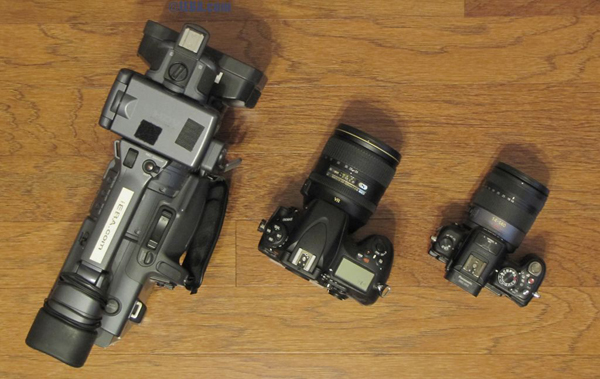Review: Nikon D800 DSLR, Part 2: Usability and Image Quality
In Part 1 of this two-part series on the Nikon D800, I looked at the operation and functionality of the D800 DSLR as a video camera. Now, in Part 2, I'll share some usability notes, as report the results of some audio and video tests (with test footage) comparing the D800 to another highly regarded DSLR, the Panasonic GH2--to see if a lower-priced but very capable DSLR can measure up with quality glass--and to a more traditional prosumer camcorder.
There’s no question that video-capable DSLRs deliver a very different look from what you get with a prosumer camcorder, for about the same price. Plus you get killer stills, something no video camera—not even a 5K RED Epic—is going to match. This is especially the case when the camera is the 36 MP, full-frame, Nikon D800.
The D800 and Nikkor 24-120mm VR lens system I received from Nikon for review lists for $4,200. A decent prosumer camcorder, like the Panasonic AG-AC160, which I had an opportunity to test a few months ago, has a street price just north of $4,000. So they are definitely comparable in price. The real issue is the look of the image, as well as usability and features.
In Part 1 of this two-part series on the D800, I looked at the operation and functionality of the D800 as a video camera. Now, in Part 2, I'll share some usability notes, as report the results of some audio and video tests comparing the D800 to another highly regarded DSLR, the Panasonic GH2, and to a more traditional prosumer camcorder (Figure 1, below).

Figure 1. Ever Smaller (left to right): The prosumer camcorder, the Nikon D800, the Panasonic GH2.
Ergonomics
A good portion of DLSRs are used in independent filmmaking. There, you take time to set up for a shot. You shoot the shot. You stop. You make adjustments. You repeat the whole process again. And again. And again. A camera where everything is completely manual, and where it takes time to nail your focus, adjust your audio levels precisely each time, is perfectly fine.
Another sizable portion of these cameras are used in situations where you need to record long takes “on the fly,” or shoot various events and situations as they happen, where you can’t force everyone there to stop on a dime so you can twiddle with your focus. You have to make these adjustments while you shoot.
I attempted to record some live action video with the D800 and the included lens. My attempts to keep the subject in focus, even at f/11, were often thwarted by four factors:
- Still-camera lenses have a very short rotational distance between very close and infinity. On my beautiful loaner Nikkor 24-120mm VR lens, it takes a quarter rotation of the focus ring to go from closer than 2 feet to infinity. In reality, most everything I need to shoot is 5 or more feet away. The amount of rotation from 5 feet to infinity is the width of my thumb. Given that your depth of field may be as little as a few inches, trying to make that few inches match the exact distance of my subject to the camera while they, and I, are moving, is close to impossible.
- The D800 does not offer autofocus while shooting video. The only DSLR (with mirror) that has this capability currently is the Canon T4i. My comparison camera, the mirrorless Panasonic GH2, can autofocus while recording video. Any camcorder can do this. While many professional shooters prefer to focus manually, not having autofocus available at all presents a new, and possibly substantial, challenge.
- The D800 offers no focus assist while recording. There’s no way to punch in on the image, no peaking, no distance scale. So if you plan on using the on-camera monitor with a loupe, know the camera’s limitations beforehand. There are some external HDMI monitors that allow you to punch in to 1:1 pixels size to make getting critical focus easier, and you can do this while recording video in the camera.
- Lastly, using a half-press of the shutter button while recording video does force the camera to refocus--but in a “still camera” sort of way. It rolls the focus back, then forth, then back, and then it focuses. There's nothing subtle about it. If you try it in the middle of a shot, you’ll probably want to edit that part out. But if you need focus fast and don't know which way to go, what I have come to call “Autofocus Assist” (see video below) can get you there in a pinch.
Related Articles
In the P7700, Nikon has improved on earlier P7000 models with numerous video formats and a microphone input, plus a tilt-swivel display and several under-the-hood improvements. Is this the video-and-stills powerhouse I've been waiting for?
D7100 features 24.1 megapixel CMOS sensor, 51 focus points including 15 cross-type sensors, 100-6400 ISO range, and new WU-1a wireless mobile adapter
In this two-part series, we'll examine how well Nikon's much-heralded D800 DSLR works as a video camera, in terms of operability and functionality. In part two, we'll report on some audio and video tests comparing the D800 to another highly regarded DSLR, and to a more traditional prosumer camcorder.